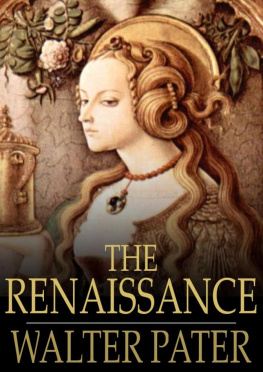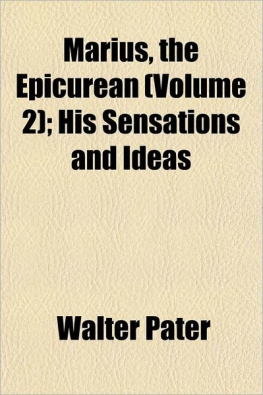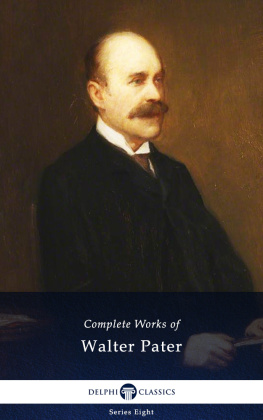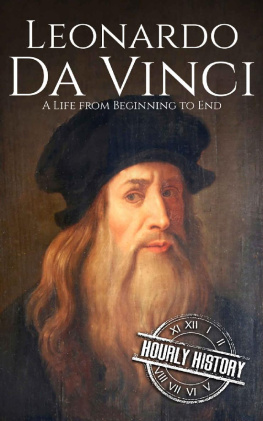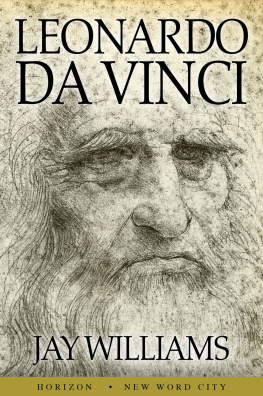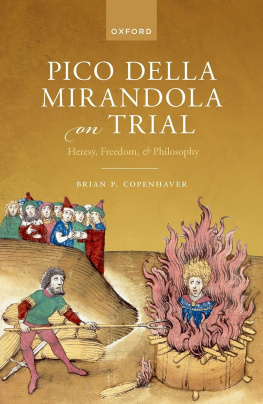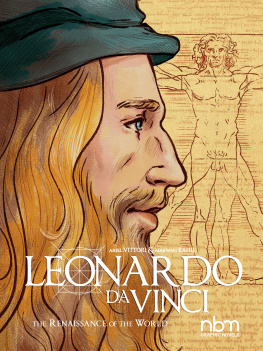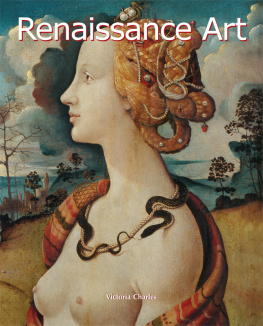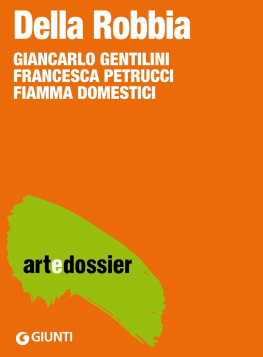Pater - The Renaissance: Studies of Art and Poetry
Here you can read online Pater - The Renaissance: Studies of Art and Poetry full text of the book (entire story) in english for free. Download pdf and epub, get meaning, cover and reviews about this ebook. City: Wellington, year: 2010, publisher: The Floating Press, genre: Science. Description of the work, (preface) as well as reviews are available. Best literature library LitArk.com created for fans of good reading and offers a wide selection of genres:
Romance novel
Science fiction
Adventure
Detective
Science
History
Home and family
Prose
Art
Politics
Computer
Non-fiction
Religion
Business
Children
Humor
Choose a favorite category and find really read worthwhile books. Enjoy immersion in the world of imagination, feel the emotions of the characters or learn something new for yourself, make an fascinating discovery.
The Renaissance: Studies of Art and Poetry: summary, description and annotation
We offer to read an annotation, description, summary or preface (depends on what the author of the book "The Renaissance: Studies of Art and Poetry" wrote himself). If you haven't found the necessary information about the book — write in the comments, we will try to find it.
Pater: author's other books
Who wrote The Renaissance: Studies of Art and Poetry? Find out the surname, the name of the author of the book and a list of all author's works by series.
The Renaissance: Studies of Art and Poetry — read online for free the complete book (whole text) full work
Below is the text of the book, divided by pages. System saving the place of the last page read, allows you to conveniently read the book "The Renaissance: Studies of Art and Poetry" online for free, without having to search again every time where you left off. Put a bookmark, and you can go to the page where you finished reading at any time.
Font size:
Interval:
Bookmark:

The Renaissance
Studies of Art and Poetry
First published in 1873
ISBN 978-1-775419-33-4
2010 The Floating Press
While every effort has been used to ensure the accuracy and reliability of the information contained in The Floating Press edition of this book, The Floating Press does not assume liability or responsibility for any errors or omissions in this book. The Floating Press does not accept responsibility for loss suffered as a result of reliance upon the accuracy or currency of information contained in this book. Do not use while operating a motor vehicle or heavy equipment. Many suitcases look alike.
Visit www.thefloatingpress.com
Sixth Edition
To C.L.S.
Many attempts have been made by writers on art and poetry to definebeauty in the abstract, to express it in the most general terms, to finda universal formula for it. The value of these attempts has most oftenbeen in the suggestive and penetrating things said by the way. Suchdiscussions help us very little to enjoy what has been well done in artor poetry, to discriminate between what is more and what is lessexcellent in them, or to use words like beauty, excellence, art, poetry,with a more precise meaning than they would otherwise have. Beauty, likeall other qualities presented to human experience, is relative; and thedefinition of it becomes unmeaning and useless in proportion to itsabstractness. To define beauty, not in the most abstract, but in themost concrete terms possible, to find, not a universal formula for it,but the formula which expresses most adequately this or that specialmanifestation of it, is the aim of the true student of aesthetics.
"To see the object as in itself it really is," has been justly said tobe the aim of all true criticism whatever; and in aesthetic criticismthe first step towards seeing one's object as it really is, is to knowone's own impression as it really is, to discriminate it, to realise itdistinctly. The objects with which aesthetic criticism dealsmusic,poetry, artistic and accomplished forms of human lifeare indeedreceptacles of so many powers or forces: they possess, like the productsof nature, so many virtues or qualities. What is this song or picture,this engaging personality presented in life or in a book, to ME? Whateffect does it really produce on me? Does it give me pleasure? and ifso, what sort or degree of pleasure? How is my nature modified by itspresence, and under its influence? The answers to these questions arethe original facts with which the aesthetic critic has to do; and, as inthe study of light, of morals, of number, one must realise such primarydata for oneself, or not at all. And he who experiences theseimpressions strongly, and drives directly at the discrimination andanalysis of them, has no need to trouble himself with the abstractquestion what beauty is in itself, or what its exact relation to truthor experiencemetaphysical questions, as unprofitable as metaphysicalquestions elsewhere. He may pass them all by as being, answerable ornot, of no interest to him.
The aesthetic critic, then, regards all the objects with which he has todo, all works of art, and the fairer forms of nature and human life, aspowers or forces producing pleasurable sensations, each of a more orless peculiar or unique kind. This influence he feels, and wishes toexplain, analysing it and reducing it to its elements. To him, thepicture, the landscape, the engaging personality in life or in a book,La Gioconda, the hills of Carrara, Pico of Mirandola, are valuable fortheir virtues, as we say, in speaking of a herb, a wine, a gem; for theproperty each has of affecting one with a special, a unique, impressionof pleasure. Our education becomes complete in proportion as oursusceptibility to these impressions increases in depth and variety. Andthe function of the aesthetic critic is to distinguish, analyse, andseparate from its adjuncts, the virtue by which a picture, a landscape,a fair personality in life or in a book, produces this specialimpression of beauty or pleasure, to indicate what the source of thatimpression is, and under what conditions it is experienced. His end isreached when he has disengaged that virtue, and noted it, as a chemistnotes some natural element, for himself and others; and the rule forthose who would reach this end is stated with great exactness in thewords of a recent critic of Sainte-Beuve:De se borner a connaitre depres les belles choses, et a s'en nourrir en exquis amateurs, enhumanistes accomplis.
What is important, then, is not that the critic should possess a correctabstract definition of beauty for the intellect, but a certain kind oftemperament, the power of being deeply moved by the presence ofbeautiful objects. He will remember always that beauty exists in manyforms. To him all periods, types, schools of taste, are in themselvesequal. In all ages there have been some excellent workmen, and someexcellent work done. The question he asks is always:In whom did thestir, the genius, the sentiment of the period find itself? where was thereceptacle of its refinement, its elevation, its taste? "The ages areall equal," says William Blake, "but genius is always above its age."
Often it will require great nicety to disengage this virtue from thecommoner elements with which it may be found in combination. Fewartists, not Goethe or Byron even, work quite cleanly, casting off alldebris, and leaving us only what the heat of their imagination haswholly fused and transformed. Take, for instance, the writings ofWordsworth. The heat of his genius, entering into the substance of hiswork, has crystallised a part, but only a part, of it; and in that greatmass of verse there is much which might well be forgotten. But scatteredup and down it, sometimes fusing and transforming entire compositions,like the Stanzas on Resolution and Independence, and the Ode on theRecollections of Childhood, sometimes, as if at random, depositing afine crystal here or there, in a matter it does not wholly searchthrough and transform, we trace the action of his unique, incommunicablefaculty, that strange, mystical sense of a life in natural things, andof man's life as a part of nature, drawing strength and colour andcharacter from local influences, from the hills and streams, and fromnatural sights and sounds. Well! that is the virtue, the activeprinciple in Wordsworth's poetry; and then the function of the critic ofWordsworth is to follow up that active principle, to disengage it, tomark the degree in which it penetrates his verse.
The subjects of the following studies are taken from the history of theRenaissance, and touch what I think are the chief points in thatcomplex, many-sided movement. I have explained in the first of them whatI understand by the word, giving it a much wider scope than wasintended by those who originally used it to denote only that revival ofclassical antiquity in the fifteenth century which was but one of manyresults of a general excitement and enlightening of the human mind, ofwhich the great aim and achievements of what, as Christian art, is oftenfalsely opposed to the Renaissance, were another result. This outbreakof the human spirit may be traced far into the middle age itself, withits qualities already clearly pronounced, the care for physical beauty,the worship of the body, the breaking down of those limits which thereligious system of the middle age imposed on the heart and theimagination. I have taken as an example of this movement, this earlierRenaissance within the middle age itself, and as an expression of itsqualities, two little compositions in early French; not because theyconstitute the best possible expression of them, but because they helpthe unity of my series, inasmuch as the Renaissance ends also in France,in French poetry, in a phase of which the writings of Joachim du Bellayare in many ways the most perfect illustration; the Renaissance thusputting forth in France an aftermath, a wonderful later growth, theproducts of which have to the full that subtle and delicate sweetnesswhich belongs to a refined and comely decadence; just as its earliestphases have the freshness which belongs to all periods of growth in art,the charm of ascesis, of the austere and serious girding of the loins inyouth.
Font size:
Interval:
Bookmark:
Similar books «The Renaissance: Studies of Art and Poetry»
Look at similar books to The Renaissance: Studies of Art and Poetry. We have selected literature similar in name and meaning in the hope of providing readers with more options to find new, interesting, not yet read works.
Discussion, reviews of the book The Renaissance: Studies of Art and Poetry and just readers' own opinions. Leave your comments, write what you think about the work, its meaning or the main characters. Specify what exactly you liked and what you didn't like, and why you think so.

